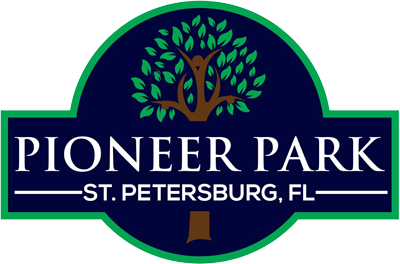History of Pioneer Park
The beautiful waterfront views and the luscious green grass are to many what make up Pioneer Park. However, the history of Pioneer Park is far richer, and it’s cultural roots run deep within the heritage of St. Pete natives and locals.
Origins
The 20-foot-tall obelisk monument at the heart of Pioneer Park commemorates the many distinctive early settlers who, in the 1800s and early 1900s, imagined a city on this sparsely settled sub-peninsula of Florida. They began to build the city of their dreams and had the foresight to preserve the waterfront for public use. They sought to lay out a systematic plan for city streets, and to create access to the peninsula from surrounding areas.

However, it would not be until nearly a century later that the City of St. Petersburg’s Pioneers’ legacy would be immortalized within Pioneer Park. In 1976, Jay B. Starkey, Sr., who was himself a son of St. Petersburg pioneers, initiated a project to establish a memorial to the men and women who bravely and successfully began turning St. Pete into the vibrant oasis of culture, diversity, and unity that we know and love today. With a substantial contribution of Starkey’s own money, a group of likeminded descendants of pioneers and interested citizens, and with the cooperation of the City Council and City Leisure Services Department, Pioneer Park was dedicated on November 26, 1981.
Pioneer Park Foundation, Inc. was started at this time to ensure the Park would be watched over and well maintained. A major revitalization of Pioneer Park was celebrated on February 26, 2012.
Pioneer Park’s History in Photographs

1898
This is the view, circa 1898, looking westward from the railroad pier which ran towards present day First Avenue SE. The building with the smokestack is an ice plant. The building on the right is the Clarendon Hotel, which was destroyed by fire in December 1899. Courtesy St. Petersburg Museum of History. A reminder that the railroad played an important role in the early formation of St. Petersburg.

Date Unknown
This image is of the land that would much later become Pioneer Park. Note the radio tower on the left that was at the intersection of Central Avenue and Bay Shore Dr. In the distance on the right the Railroad Pier can be seen. Photo courtesy of St. Petersburg Museum of History.

Date Unknown
This is the early St. Petersburg waterfront, the location of today’s St. Petersburg Marina. A close neighbor of the Pioneer Park, the marina too has a rich history. Itself housing a variety of tourist attractions and St. Pete Piers over the last century, it is a breathtaking icon of St. Pete’s history. Image courtesy of the City of St. Petersburg.

Date Unknown
This undated image features Al Lang Field in the left center. The block on which Pioneer Park is now located is just behind (to the North) Al Lang Field. Image courtesy of the City of St. Petersburg.

1973
This aerial, taken on 12/27/73, was part of the St. Petersburg Times’ coverage of the City’s plan to make the “South Mole” property, owned by and leased from the Seaboard Coast Line Railroad, into what today is known as Demens Landing Park. The Pioneer Park property was the vacant land to the immediate east of the Bayfront Tower building, then under construction.

1980
Pioneer Park, as it was in the process of its original construction in December, 1980. The former building of the St. Petersburg Yacht Club is lower right. Photo courtesy of William H. Mills, III “Billy”.
Support the Foundation
Pioneer Park Foundation, Inc. is a not for profit 501(c)(3) organization. We manage a permanent Trust Fund to protect and maintain Pioneer Park in St. Petersburg, FL. Charitable donations for the ongoing care of Pioneer Park are welcomed and needed to maintain the Park in peak condition. Donations may be made in honor of or in memory of friends and loved ones. Your donation is fully tax-deductible to the extent allowable by law.
